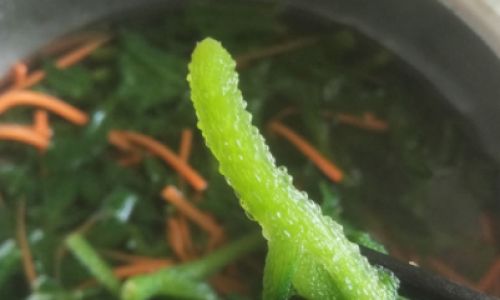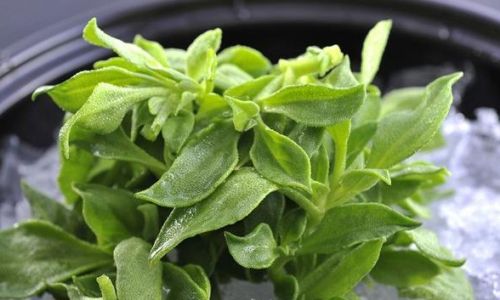Introduction
Ice plant, scientifically known as Mesembryanthemum crystallinum, is a succulent herbaceous plant native to coastal regions of South Africa. Renowned for its striking appearance—adorned with glistening, bead-like trichomes that resemble frozen dew drops—this resilient green has transcended its origins to become a culinary curiosity in kitchens worldwide. While often celebrated in salads or as a garnish, a lingering question persists among adventurous home cooks: Can ice plant be stir-fried? This article delves into the botanical traits, culinary versatility, and practical steps to transform this crunchy delicacy into a savory stir-fry dish.

Understanding Ice Plant: Botany and Culinary Relevance
Ice plant thrives in arid, saline environments, a testament to its ability to retain moisture through fleshy leaves and stems. Its natural habitat spans Mediterranean climates, where it has historically been harvested for both medicinal and culinary purposes. The plant’s leaves, which range from vibrant green to hues of purple, boast a unique texture: crisp, slightly mucilaginous when raw, and briny, with a mild, ocean-like flavor reminiscent of sea beans or samphire.
Nutritionally, ice plant is a powerhouse of antioxidants, including beta-carotene and vitamin C, alongside dietary fiber and minerals like magnesium and potassium. Its low-calorie profile and high water content make it an appealing addition to health-conscious diets. However, its culinary appeal extends beyond nutrition; the plant’s inherent saltiness and crunch offer a refreshing contrast to blander greens.
Stir-Frying 101: The Science Behind High-Heat Cooking
Stir-frying, a cornerstone of Asian cuisine, involves cooking small, uniform pieces of food in a wok or skillet over intense heat, typically with minimal oil. The technique preserves texture, locks in flavors, and ensures even cooking. For ice plant, which is relatively delicate, mastering the balance between heat and cooking time is critical to avoiding sogginess.
Preparing Ice Plant for Stir-Frying
-
Harvesting and Selection:
- Opt for fresh, young ice plant leaves, as older stems may become fibrous.
- If foraging, ensure the plant has not been exposed to pollutants; cultivated varieties from reputable sources are safest.
-
Cleaning:
- Rinse leaves thoroughly under cold water to remove sand or debris.
- Pat dry gently to retain trichomes, which contribute to texture.
-
Cutting:
- Trim tough stems and chop leaves into bite-sized pieces (2–3 cm).
- For added crunch, separate tender stems from leaves; stems may require slightly longer cooking.
Stir-Frying Ice Plant: Techniques and Flavor Pairings
Stir-fried ice plant thrives when paired with complementary ingredients that enhance its natural brininess. Here’s a step-by-step guide to achieving perfection:

-
Heat the Wok:
- Preheat a carbon-steel wok over high heat until wisps of smoke rise.
- Add 1–2 tablespoons of neutral oil (e.g., grapeseed, peanut) and swirl to coat.
-
Aromatics:
- Sauté minced garlic, ginger, or shallots until fragrant (15–20 seconds).
- For a spicy kick, add sliced chili peppers or a dash of red pepper flakes.
-
Protein (Optional):
- Stir-fry thinly sliced chicken, shrimp, or tofu for 2–3 minutes until cooked through.
- Set aside to prevent overcooking.
-
Vegetables:
Introduce quick-cooking vegetables (e.g., bell peppers, snap peas, mushrooms) and stir-fry for 1–2 minutes.
-
Ice Plant:
- Add the prepared ice plant and toss vigorously for 1–2 minutes.
- Avoid overcrowding the wok; cook in batches if necessary.
-
Seasoning:
- Drizzle with soy sauce, oyster sauce, or a splash of rice vinegar.
- For a umami boost, sprinkle with toasted sesame oil or a pinch of sea salt.
-
Finish:

- Return protein to the wok and toss to combine.
- Garnish with sesame seeds, cilantro, or thinly sliced scallions.
Flavor Pairings and Regional Inspirations
- Asian-Inspired: Combine ice plant with shiitake mushrooms, bok choy, and a soy-ginger glaze.
- Mediterranean Twist: Pair with roasted cherry tomatoes, olives, and a drizzle of lemon-infused olive oil.
- Spicy Sichuan: Toss with doubanjiang (fermented bean paste), Sichuan peppercorns, and crushed peanuts.
Nutritional Considerations: Does Stir-Frying Affect Benefits?
Stir-frying ice plant preserves most of its nutritional value, as the quick cooking time minimizes nutrient loss. However, excessive heat may degrade heat-sensitive vitamins like vitamin C. To mitigate this:
- Use minimal oil and avoid prolonged cooking.
- Serve immediately to retain crispness and vibrancy.
Troubleshooting Common Issues
- Sogginess: Overcooking causes ice plant to release moisture. Stir-fry for no more than 2 minutes.
- Blandness: Enhance flavor with umami-rich ingredients (e.g., miso, fish sauce) or a squeeze of citrus.
- Bitterness: Balance with a pinch of sugar or honey during cooking.
Cultural Context: Ice Plant in Global Cuisines
While ice plant remains niche in many Western markets, it holds a revered place in Mediterranean and Asian diets:
- Italy: Known as agretto, it graces springtime menus in frittatas and pasta dishes.
- Japan: Called tsukushi, it is pickled or blanched and served with rice.
- Mexico: Verdolaga (purslane, a related species) is stir-fried with nopales and chili.
Beyond Stir-Fries: Alternative Cooking Methods
- Sautéing: Cook ice plant briefly in butter with lemon zest for a decadent side.
- Grilling: Thread leaves onto skewers and char briefly for smoky notes.
- Soups: Add to miso or chicken broth during the final minutes of simmering.
Growing Ice Plant at Home: A Sustainable Choice
For avid gardeners, ice plant is a low-maintenance addition to xeriscapes or container gardens. Its drought tolerance and pest resistance make it ideal for novice growers. Harvest leaves year-round, ensuring a steady supply for culinary experiments.
Conclusion: Embracing Ice Plant’s Culinary Potential
Ice plant’s transition from ornamental curiosity to stir-fry star is a testament to its adaptability and flavor. When cooked with precision, it retains its signature crunch while absorbing the vibrant tapestry of aromatics and seasonings. Whether paired with protein, vegetables, or grains, stir-fried ice plant offers a bridge between novelty and tradition—a crisp, saline reminder that even the humblest greens can elevate a meal to extraordinary heights. So, the next time you encounter this glistening wonder, dare to wield your wok: the sizzle of success awaits.





0 comments